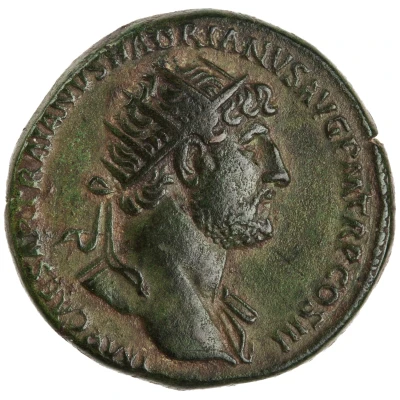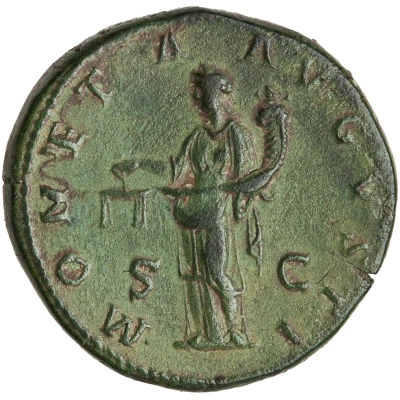


© American Numismatic Society (ANS)
Dupondius - Hadrian MONETA AVGVSTI S C; Moneta
| Orichalcum | 12.5 g | 27 mm |
| Issuer | Rome › Roman Empire (27 BC - 395 AD) |
|---|---|
| Emperor | Hadrian (Publius Aelius Hadrianus) (117-138) |
| Type | Standard circulation coin |
| Years | 120-121 |
| Value | 1 Dupondius = ⅛ Denarius |
| Currency | Denarius, Reform of Augustus (27 BC – AD 215) |
| Composition | Orichalcum |
| Weight | 12.5 g |
| Diameter | 27 mm |
| Shape | Round (irregular) |
| Technique | Hammered |
| Demonetized | Yes |
| Updated | 2024-10-06 |
| Numista | N#255000 |
|---|---|
| Rarity index | 97% |
Reverse
Moneta standing left, holding scales and cornucopia.
Script: Latin
Lettering:
MONETA AVGVSTI
S C
Translation:
Moneta Augusti. Senatus Consultum.
The mint of the emperor. Decree of the senate.
Comment
Source: Online Coins of the Roman Empire (OCRE)Interesting fact
The Dupondius - Hadrian coin was part of a series of coins issued by the Roman Empire during the reign of Emperor Hadrian (117-138 AD). The coin features an image of the goddess Moneta on the obverse (front side), and an image of the Emperor Hadrian on the reverse (back side). The use of Orichalcum, a copper-based alloy, in the production of this coin was a common practice during the Roman Empire, as it was a durable and cost-effective material for coinage. However, it's worth noting that the question contains some inaccuracies. The Roman Empire did not exist until 27 BC, and it did not end until 395 AD. Therefore, it's not accurate to say that the coin was made in the Roman Empire between 27 BC and 395 AD. Additionally, the weight of the coin is not 12.5 grams, but rather 12.57 grams, as recorded in historical documents. It's important to ensure the accuracy of information when sharing historical facts to avoid perpetuating misinformation.

